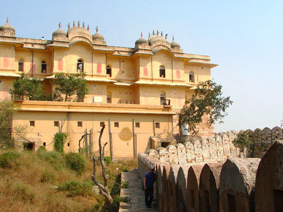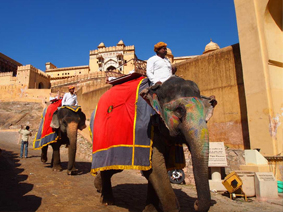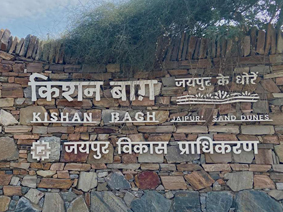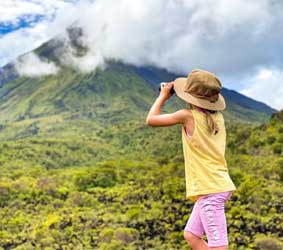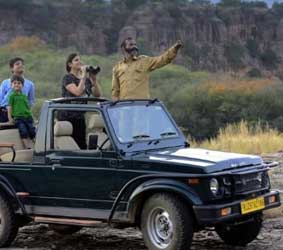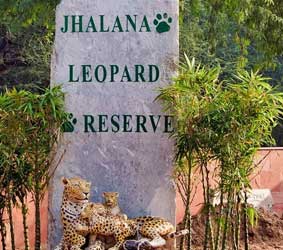| Jhalana | Amagarh Safari Tariff | |
|---|---|
| Full Jeep |
INR 6700 / Jeep (Maximum 6 Persons are allowed in ONE Jeep Indian) |
| Jeep ( Single Seat) |
INR 1250 / Person (Maximum 6 Person are allowed in ONE Jeep Indian) |
| Safari Zone |
Jhalana | Amagarh |
| Safari Timing |
07:00 am – 09:30 am | 03:15 pm to 05:45 pm |
| The Price Includes |
Jeep & Driver, Permit Charges, Guide Charges, Online Payment Gateway Charges & Our Service Charges and Taxes. |
| Note |
Jeep Safari are non refundable. Safari Booking will be CLOSED after 10:00 PM for Next Day Booking. |
| Maximum 6 Adults and 1 child (5 years Blow) are allowed in 1 Jeep | |
| You have to pay full fees for safari booking in advance. | |
| ID proof is a must for each and every visitor. | |
| Note : If Some Seats In Jeep Safari Remained Un Booked Then All The Other Members Have To Pay For Empty Seats | |
| The visitors are required to report at the boarding place 15 min prior to the scheduled departure of the safari. | |
Jhalana Online Safari Booking
Jhalana Leopard Safari Park
Jhalana Leopard Safari Park is a popular wildlife sanctuary located in Jaipur, Rajasthan, India. The park is known for its thriving leopard population and provides a unique opportunity for wildlife enthusiasts and tourists to spot leopards in their natural habitat.
Jhalana Conservation Reserve or Jhalana Leopard Safari Park is known for its population of leopards and is considered a unique wildlife habitat within an urban landscape. The reserve covers an area of about 24 square kilometers and is home to a variety of flora and fauna. The presence of leopards in close proximity to the city of Jaipur makes Jhalana Conservation Reserve an interesting and important site for wildlife enthusiasts and researchers.
The park is home to a significant population of leopards. The rocky terrain and vegetation in the area provide an ideal habitat for these elusive big cats. Apart from leopards, the park also houses other wildlife species such as blue bulls, spotted deer, and various bird species.Visitors can explore the park through guided safaris. The safaris are conducted in open vehicles, allowing tourists to have a close encounter with the wildlife. The early morning and late afternoon safaris are considered the best times for leopard sightings.
| Nationality | Types Of Vehicle | Jhalana Jeep Price |
|---|---|---|
| Indian | Jeep ( Single Seat) | INR 1250 Per Person |
| Indian | Full Jeep | INR 6700 (6 Persons) |
| Foreigner | Jeep ( Single Seat) | INR 2100 Per Person |
| Foreigner | Full Jeep | INR 12600 (6 Persons) |
History of Jhalana Leopard Safari Park Jaipur
The Jhalana Leopard Safari Park in Jaipur, Rajasthan, is a relatively recent addition to the city's attractions. The park was officially inaugurated in December 2016, with the primary aim of promoting eco-tourism and providing a habitat for leopards within the urban landscape. Here's a brief history of the Jhalana Leopard Safari Park:
Establishment of the Pak: The idea to convert the Jhalana area into a leopard safari park was conceived to address the growing human-leopard conflict in the region. The rocky terrain and scrub vegetation of Jhalana provided a suitable environment for leopards, and creating a dedicated safari park was seen as a way to conserve the species while offering a unique experience for visitors.

Jhalana Leopard Safari
| MONTHS | JHALANA SAFARI TIMINGS: | ||
|---|---|---|---|
| From 1st Aug to 31st Oct | 06:45 am – 09:15 am | 03:45 pm – 06:15 pm | ||
| From 1st Nov to 31st Jan | 07:00 am – 09:30 am | 03:15 pm to 05:45 pm | ||
| From 1st Feb to 31st march | 06:15 am – 08:45 am | 03:45 pm to 06:15 pm | ||
| From 1st April to 31st May | 05:45 am – 08:15 am | 04:15 pm to 06:45 pm | ||
| From 1st May to 31st July | 05:45 am – 08:15 am | 04:45 pm to 07:15 pm | ||
| Price (Indian) |
INR. 1250 per passenger / 6700 Full Gypsy |
| Price (Foreigner) |
INR.2100 per passenger / 12600 Full Gypsy |
| Safari Zone |
Jhalana | Amagarh |
| The Price Includes |
Jeep & Driver, Permit Charges, Guide Charges, Online Payment Gateway Charges & Our Service Charges and Taxes. |
Near By Place to visit in Jaipur
Tourism Attraction in Jhalana
Jhalana Leopard Safari Park quickly gained popularity as a tourist attraction, drawing wildlife enthusiasts, photographers, and nature lovers. The proximity of the park to Jaipur makes it easily accessible for both locals and tourists.The park aims to promote awareness about wildlife conservation among visitors. It offers guided safaris where tourists can observe leopards and other wildlife in their natural habitat. The park also serves as an educational hub, providing information about the local flora and fauna and the importance of preserving natural habitats.The park is equipped with safari vehicles for guided tours, and visitors are accompanied by experienced guides who provide information about the wildlife and the park's conservation initiatives.

Flora and Fauna in Jhalana
Jhalana Leopard Safari Park is not just about leopards; it also boasts a diverse range of flora and fauna. The rocky landscape and scrub vegetation contribute to the park's biodiversity.
Scrub Vegetation: The Park is characterized by rocky terrain and scrub vegetation. The landscape is dominated by thorny bushes, low shrubs, and hardy plants adapted to the arid conditions of Rajasthan.
Trees and Grasses: Along with the scrub vegetation, you may find scattered trees and grasses in certain areas of the park. These provide habitat and food for various herbivores and contribute to the overall biodiversity.
Leopards: Jhalana is renowned for its leopard population, and spotting these elusive big cats is the main attraction for visitors. The rocky landscape offers a suitable habitat for leopards to thrive.
Blue Bulls (Nilgai): The Park is home to the nilgai, also known as the blue bull, which is the largest antelope species in Asia. These herbivores are commonly seen in the park.
Spotted Deer (Chital): Spotted deer, or chital, are another common herbivore species found in Jhalana. They form an important part of the leopard's prey base.
Birdlife: Jhalana is also home to various bird species. Birdwatchers may spot different birds, including raptors, waterfowl, and other resident and migratory species.
Reptiles: The Park is home to a variety of reptiles, including monitor lizards, snakes, and other lizard species.
Best Time to Visit Jhalana Leopard Safari Park
The best time to visit Jhalana Leopard Safari Park in Jaipur, Rajasthan, largely depends on the weather and the comfort of the visitors. However, for wildlife enthusiasts hoping to maximize their chances of spotting leopards and other wildlife, it's essential to consider the behavior of the animals and their activity patterns. Here are some factors to consider when planning a visit to Jhalana Leopard Safari Park:
Winter Months (October to March): This is generally considered the best time to visit Jhalana Leopard Safari Park. The weather during these months is cool and pleasant, making it comfortable for safaris. Moreover, the vegetation is less dense, improving visibility. Leopards are also more active during the cooler hours of the day, increasing the chances of sightings. The period from November to February is particularly favorable.
Early Morning and Late Afternoon: Regardless of the season, early morning and late afternoon are the optimal times for wildlife safaris. During these hours, the temperature is cooler, and animals, including leopards, are more active. The lighting conditions are also favorable for photography.
Avoid Extreme Summer Months (April to June): The summer months in Rajasthan can be extremely hot, with temperatures soaring. During this time, wildlife tends to be less active during the peak heat of the day. Additionally, the vegetation may be denser, making it more challenging to spot animals. It's advisable to avoid planning a visit during the peak summer months.
Post-Monsoon (July to September): While the monsoon season brings a burst of greenery to the region, the park might be closed or have restricted access due to safety concerns. The trails can become muddy and challenging for safaris during heavy rainfall.
Popular Tourism Activity in Jhalana National Park
One of the most popular tourism activities in Jhalana National Park is the jeep safari. Jhalana National Park strategically located in Jaipur, Rajasthan is well-known for its leopard population and the jeep safari offers visitors a chance to spot these elusive big cats in their natural habitat. The safari also provides opportunities to see other wildlife such as deer, peacocks, jackals and various bird species.The park offers both morning and evening safari slots, and the duration of each safari is typically around 2-3 hours. During the safari knowledgeable guides accompany visitors providing insights into the park's flora and fauna well as tips for spotting wildlife.In addition to jeep safaris, Jhalana National Park also offers nature walks and bird-watching tours, which are great for those interested in the park's diverse avian population.
Jhalana National Park's popularity can be attributed to several factors:
Ample of Leopard Population in Park: One of the key attractions of Jhalana is its high density of leopards. This makes it one of the best places in India to spot these elusive big cats increasing its appeal to wildlife enthusiasts and photographers.
Proximity to Jaipur: The Park’s location within Jaipur city makes it easily accessible for both locals and tourists. Visitors can conveniently include a safari in Jhalana as part of their itinerary when exploring Jaipur, one of India's most popular tourist destinations.
Natural and Scenic Beauty of the Park: The park's diverse landscape which includes dense forests, open grasslands and rocky outcrops, provides a picturesque setting for wildlife viewing and photography.
Unique Biodiversity: Besides leopards, Jhalana is home to a variety of other wildlife, including deer, peacocks, jackals, hyenas and numerous bird species. This biodiversity attracts nature lovers and bird watchers.
Well-Organized Safaris: The Park offers well-organized jeep safaris with knowledgeable guides who provide valuable insights into the park's flora and fauna, enhancing the overall experience for visitors.
Unique Urban Wildlife Experience: As one of the few places where you can experience a wildlife safari within an urban setting, Jhalana offers a unique juxtaposition of city life and wilderness, which is rare and intriguing for many visitors.
Frequently Asked Questions
Q. What is Jhalana Leopard Reserve?
Jhalana Leopard Reserve is a wildlife conservation area located in Jaipur, Rajasthan, known for its population of leopards and other wildlife.
Q. Where is Jhalana Leopard Reserve located?
Jhalana Leopard Reserve is situated within the city limits of Jaipur, making it unique as an urban wildlife conservation area.
Q. How big is Jhalana Leopard Reserve?
The reserve spans approximately 24.45 square kilometers.
Q. What wildlife can be found in Jhalana Leopard Reserve?
The reserve is known for its leopard population, and visitors may also encounter various bird species and other wildlife.

Q. Is there any accommodation available within Jhalana Leopard Reserve?
As of my last update, there might not be accommodations within the reserve itself, but Jaipur city offers a range of lodging options.
Q. How can I reach Jhalana Leopard Reserve?
Visitors can reach Jaipur by air, train, or road, as it is well-connected to major cities in India. From Jaipur, the reserve is easily accessible.
Q. Are safaris available in Jhalana Leopard Reserve?
Yes, guided leopard safaris are available, providing visitors with the opportunity to observe leopards in their natural habitat.
Q. Is Jhalana Leopard Reserve open to the public?
Yes, the reserve is open to the public, and visitors can explore it through guided safaris.
Q. What is the best time to visit Jhalana Leopard Reserve?
The best time to visit is typically during the winter months (October to March) when the weather is more pleasant.
Q. Is there an entry fee for Jhalana Leopard Reserve?
Yes, there is usually an entry fee for visitors, and it may vary for Indian and foreign tourists.
How to Reach Jhalana Leopard Safari Park, Jaipur
Jhalana Leopard Safari Park is located in Jaipur, Rajasthan, and it is easily accessible by various modes of transportation. Here are the common ways to reach Jhalana Leopard Safari Park:
By Air: Jaipur International Airport (JAI) is the nearest airport to Jhalana Leopard Safari Park. Once you arrive at the airport, you can hire a taxi or use other local transportation options to reach the safari park. The park is typically not very far from the airport.
By Train: Jaipur Junction is the main railway station in Jaipur. From Jaipur Junction, you can hire a taxi, auto-rickshaw, or use other local transportation to reach Jhalana Leopard Safari Park.
By Road: Jaipur is well-connected by road, and there are regular bus services from major cities in Rajasthan and neighboring states. Private taxis and auto-rickshaws are readily available in Jaipur. You can hire one to take you directly to Jhalana Leopard Safari Park.
Self-Drive or Rental Car: If you prefer flexibility in your travel schedule, you can rent a car and drive to Jhalana Leopard Safari Park. Jaipur has well-maintained roads, and the park is easily accessible by car.
Local Transportation in Jaipur: Once you are in Jaipur, you can use local transportation options such as auto-rickshaws and taxis to reach Jhalana Leopard Safari Park. It's a good idea to negotiate the fare or use metered taxis.
Guided Tours: Some travel agencies and tour operators offer guided tours to Jhalana Leopard Safari Park. These tours may include transportation, safari arrangements, and a guide.




